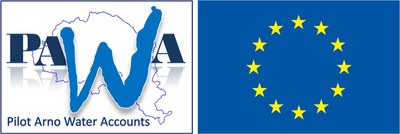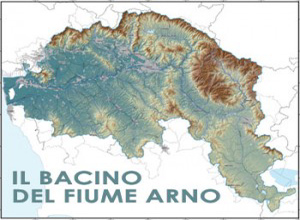PAWA
Pilot Arno Water Accounts

The project PAWA — Pilot Arno Water Accounts (Grant Agreement No. 07.0329/2013/671279/SUB/ENV.C.1) started at the beginning of January 2014 as part of the funding Call announced by the Directorate General Environment of the European Commission (DG ENV), with the aim of promoting preventive actions on European basins against desertification through a sustainable management of water resources.
The general objective of the action, which finished in March 2015, was to improve knowledge on water resources available in the Arno River basin (pilot river basin) and their use and to assess the potential impact of management, technological and economical measures to reduce the vulnerability of the territory against desertification, water scarcity and drought. In particular, PAWA aimed at testing the applicability over the Arno River Basin of the System of Environmental-Economic Accounting for Water (SEEA-Water), which will be adopted by DG ENV to provide EU water resource balances. The project results will be then useful to prepare water efficiency targets for potential future integration into Arno River Basin Management Plan (RBMP).

The Coordinating entity is the Italian Institute for Environmental Protection and Research (ISPRA), and the main partners are the Arno River Basin Agency (ARBA), Italy, and the Euro-Mediterranean Information System on know-how in the Water sector (SEMIDE/EMWIS), France.
It is important to mention that the Arno River Basin has a significant experience as pilot RB for water scarcity and drought at EU level with the definition of hydrological balances and minimal environmental flows. Under the coordination of ISPRA, Arno e Po river basins played an active role in the definition of the Water Explotation Index plus (WEI+) exercise promoted and carried out in the frame of the Water Scarcity and Drought Expert Group activities during the last programming period of the Common Implementation Strategy (CIS) for the Water Framework Directive 2000/60/EC (WFD).
The project was implemented through six activities:
- Setting the scene at Arno RBD level
- Data collection
- Building water accounts (SEEA-Water)
- Optimisation of measures
- Assessment and reporting
- Dissemination.
For each of them, several deliverables were expected to be prepared and disseminated through the PAWA website and the public FTP repository (ftp.isprambiente.it – pawapub /PUB38h76). The following documents (deliverables and techinical reports) are now available:
- D1.1 Catalogue of data sources and tools
- D1.2 Prioritisation list of sub-basins
- D2.1 Repository of data sets
- D2.2 Assessment of data availability
- D3.1 1st draft water flow diagrams and associated SEEA-Water tables
- D3.2 Geo-referenced database for water accounts
- D4.1 Water efficient targets for future revisions Arno RBMP
- D5.1 Water account tables
- D6.1 PAWA project leaflet ( two versions)
- D6.2 Compendium of lessons learnt
- D6.3 Detailed list of dissemination activities, including project presentations during events (interim version including the dissemination activities performed until December 2014).
- 4 Technical Progress Report e 1 Technical Final Report.
At river basin level, the results of PAWA will be used by ARBA and local stakeholders to improve decision making related to quantitative water resources management. At the Italian level, ISPRA will use the project outcomes for coherent developments in other river basins that will face desertification or drought and water scarcity in the future. At the EUROMED level, EMWIS will applied the PAWA results in the framework of the extension of the Shared Environmental Information System (SEIS) to South EU neighbourhood countries for structuring water information systems. Finally, at the EU level, the European Environment Agency (EEA) and DG ENV will feed the PAWA results into the WFD CIS to improve the EU wide water accounts and to provide examples of quantitative water resources management measures and related targets that could be added to RBMP as a response to the outcomes of the Blueprint to safeguard Europe’s waters.
Details about the PAWA meetings (including presentations) and the attendance of the PAWA partnership to national and international workshops and conferences can be found in the PAWA website.
AWA results were presented to DG ENV of the European Commission and to Member States during the 6th Meeting of the EU WFD CIS Working Group on Programme of Measures , which was held in Brussels on 15 October 2015. The presentation focused in particular on the project contribution to the Arno river basin management plan and the related programme of measures and on the assessment of the effect of climate change on water balance.
During the meeting, the results of other three pilot projects, namely ASSET, DURERO and WAMCD, were also presented; whereas the results of the three project that finished previously, GuaSEEAW+, PROTAGUs and SYWAG, were presented during the 3rd Meeting of the EU WFD CIS Working Group on Water Accounts (19 March 2015).
During the meeting, the results of other three pilot projects, namely ASSET, DURERO and WAMCD, were also presented; whereas the results of the three project that finished previously, GuaSEEAW+, PROTAGUs and SYWAG, were presented during the 3rd Meeting of the EU WFD CIS Working Group on Water Accounts (19 March 2015). These projects contributed with their outcomes to the realization of the "Guidance document on the application of water balances for supporting the implementation of the WFD" that was produced by the EU WFD CIS Working Group on Water Accounts.
The European Commission web page dedicated to "Water balances and water resources management targets" contains the links to the websites and final reports of the seven pilot project funded by the DG ENV call.
For any further information, please send an email to pawa@isprambiente.it.
